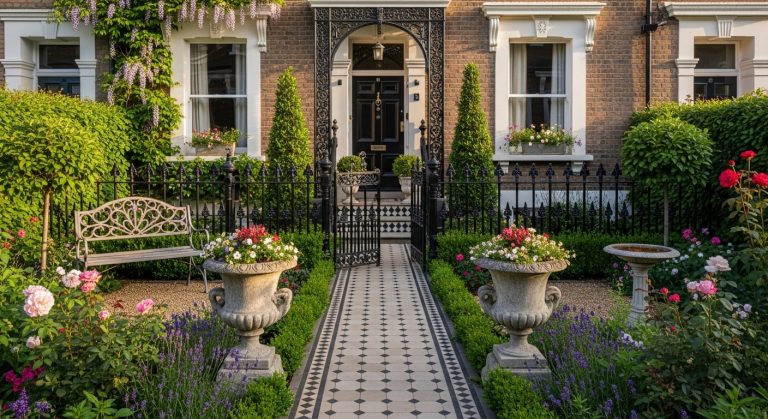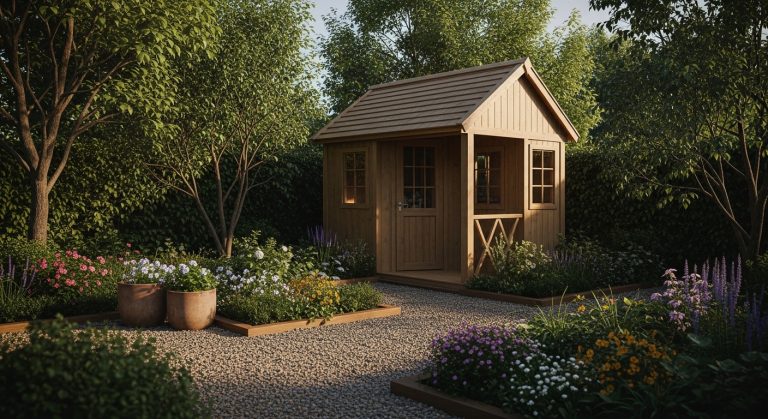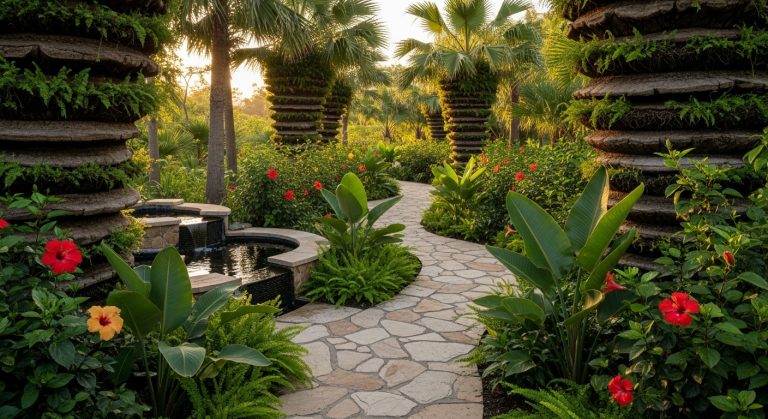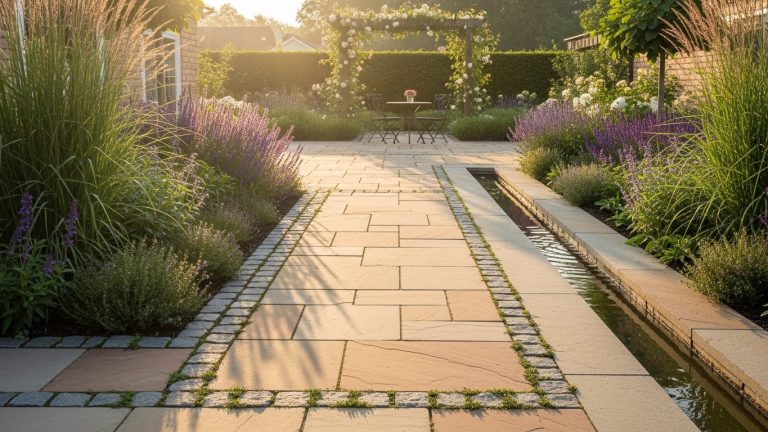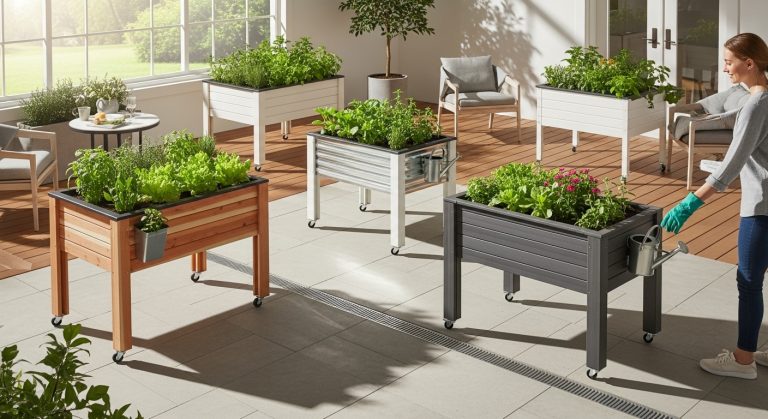Australian Native Cottage Garden Ideas That Bring Your Backyard to Life
Ever wandered past a garden and thought, “Wow, that feels effortless but somehow magical”? That’s the charm of a cottage garden, especially when it’s planted with Australian native species. There’s something so grounding about combining wild, natural textures with a cozy, structured garden layout. Over the years, I’ve found that native plants not only bring low-maintenance beauty but also attract birds and pollinators, creating a lively, ever-changing landscape.
What excites me most about Australian native cottage gardens is their ability to feel both untamed and intentional. They celebrate local flora, so your garden thrives without constant watering, while still feeling lush, colorful, and inviting. Today, I want to share 15 achievable ideas to help you create your own Australian native cottage garden—realistic setups, visually appealing, and full of personality.
1. Layered Planting with Native Perennials

Layering is key in a cottage garden. I like combining taller Grevilleas and Banksias at the back with mid-height Correas and ground-hugging Dichondra or Lomandra. The effect is a natural, flowing composition.
Pros:
- Provides year-round interest with different flowering times
- Attracts birds and pollinators
- Low-maintenance once established
Cons:
- Initial planning and spacing can be time-consuming
- Some perennials need pruning to maintain shape
Mini takeaway: A layered approach keeps the garden dynamic and full of life without constant upkeep.
2. Curved Garden Beds
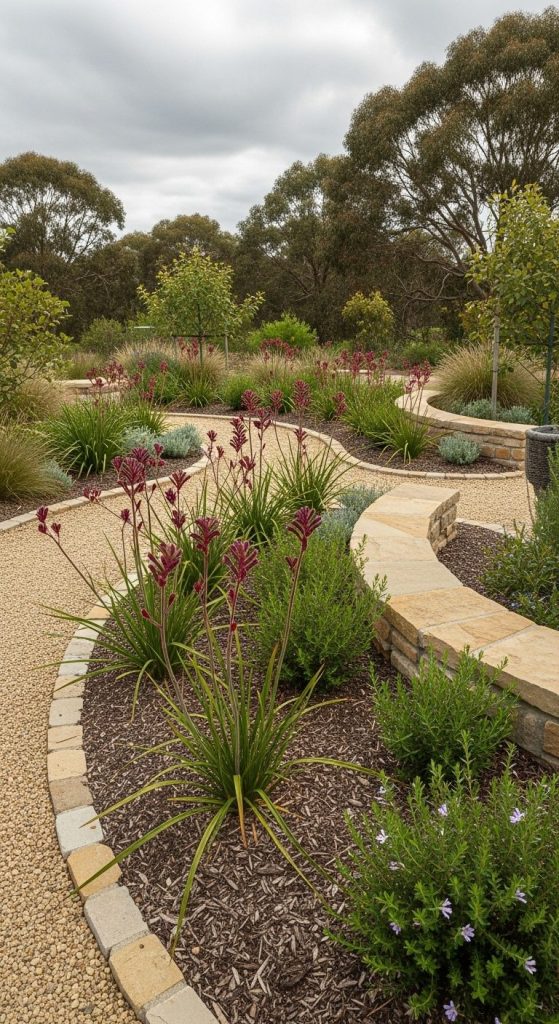
Straight lines are practical, but curves feel cozy. I often lay out garden beds in soft arcs, weaving Kangaroo Paw and Leptospermum along the edges.
Pros:
- Creates a sense of flow and intimacy
- Makes small spaces feel larger
- Encourages exploration and discovery
Cons:
- Requires more careful planning for irrigation
- Harder to mow around irregular edges
Mini takeaway: Gentle curves are simple yet transformative, giving your garden a natural, inviting rhythm.
3. Integrating Gravel Paths
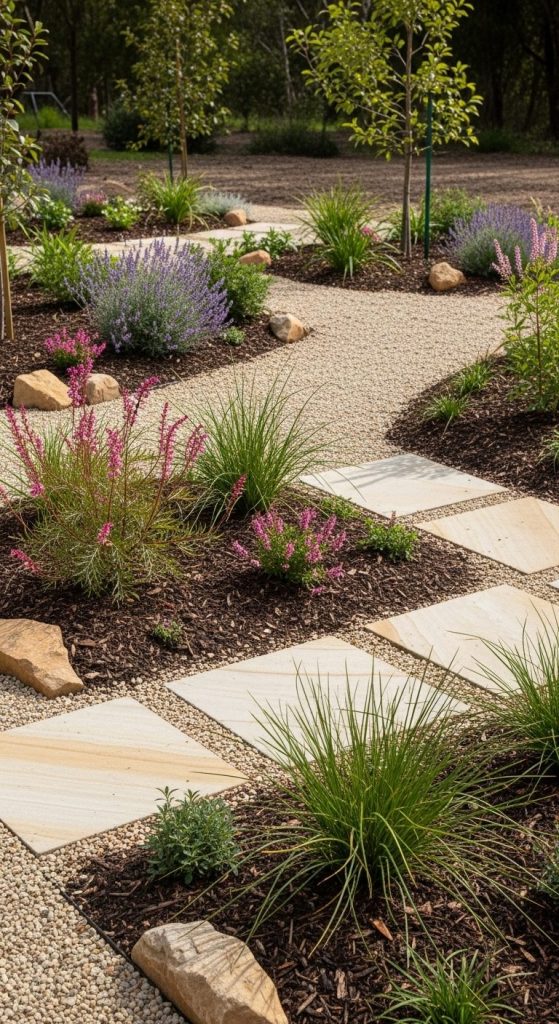
Gravel paths aren’t just functional—they bring texture. Light-colored pebble or sandstone paths guide visitors through your garden while complementing native foliage.
Pros:
- Low-cost and easy to install
- Allows water to drain naturally
- Adds rustic charm and visual contrast
Cons:
- Gravel can shift over time
- Needs occasional topping up
Mini takeaway: A simple gravel path can turn wandering through your garden into a mindful experience.
4. Vertical Interest with Trellises
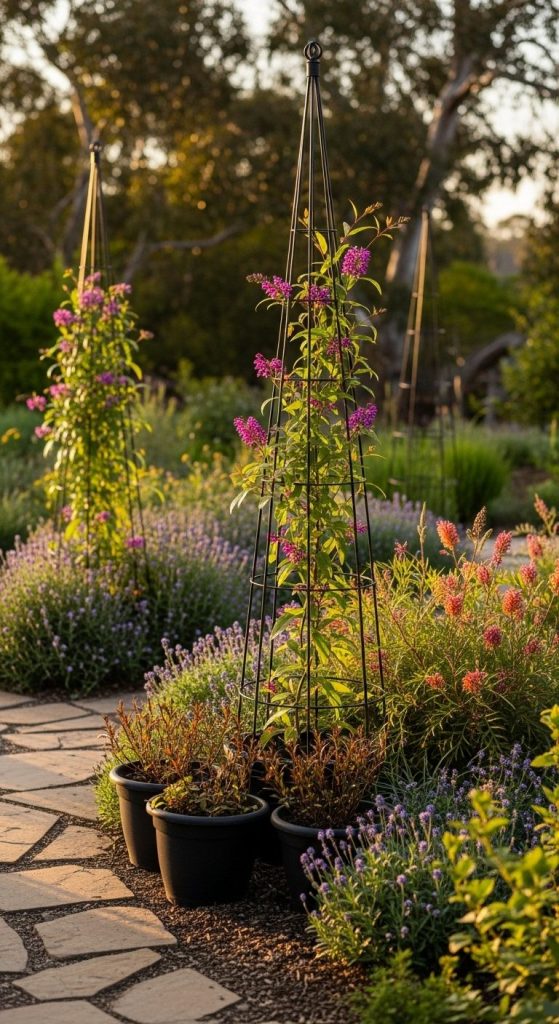
Even native gardens benefit from height. Using a Trellis with climbing natives like Hardenbergia violacea adds vertical interest without overpowering other plants.
Pros:
- Maximizes small spaces
- Provides shelter and perches for birds
- Adds seasonal flowering display
Cons:
- Some climbers require initial support
- Needs pruning to prevent overgrowth
Mini takeaway: Vertical elements balance sprawling perennials, creating a layered, cottage-like feel.
5. Incorporating Rustic Garden Furniture

A simple timber bench or weathered chair tucked among Grevilleas or Banksias creates a human connection to the space. I often place seating near flowering natives for a sensory experience.
Pros:
- Encourages garden use and relaxation
- Blends naturally with earthy tones
- Creates focal points and cozy nooks
Cons:
- Wood may need sealing or maintenance
- Positioning must consider sun and shade
Mini takeaway: A thoughtfully placed seat makes your native garden both functional and inviting.
6. Bird-Friendly Plant Selection
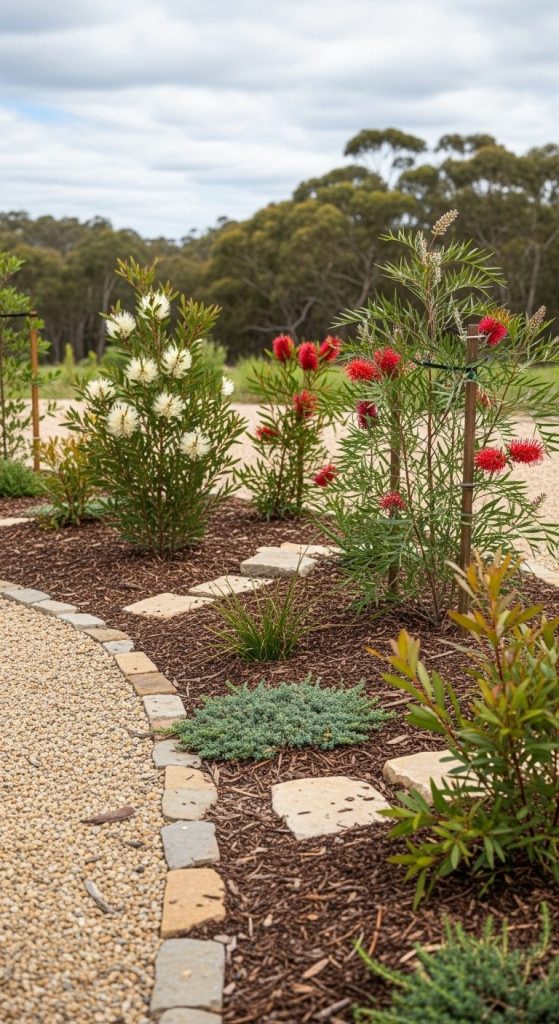
Cottage gardens feel alive when birds visit. Planting Melaleuca, Callistemon, and Grevillea ensures nectar-rich blooms for honeyeaters and small perching spaces.
Pros:
- Supports local wildlife
- Adds natural movement and sound
- Encourages pollination
Cons:
- Birds may leave droppings
- Some species attract insects
Mini takeaway: Native plants and birds are a natural partnership that animates your garden with minimal effort.
7. Mulch for Texture and Moisture
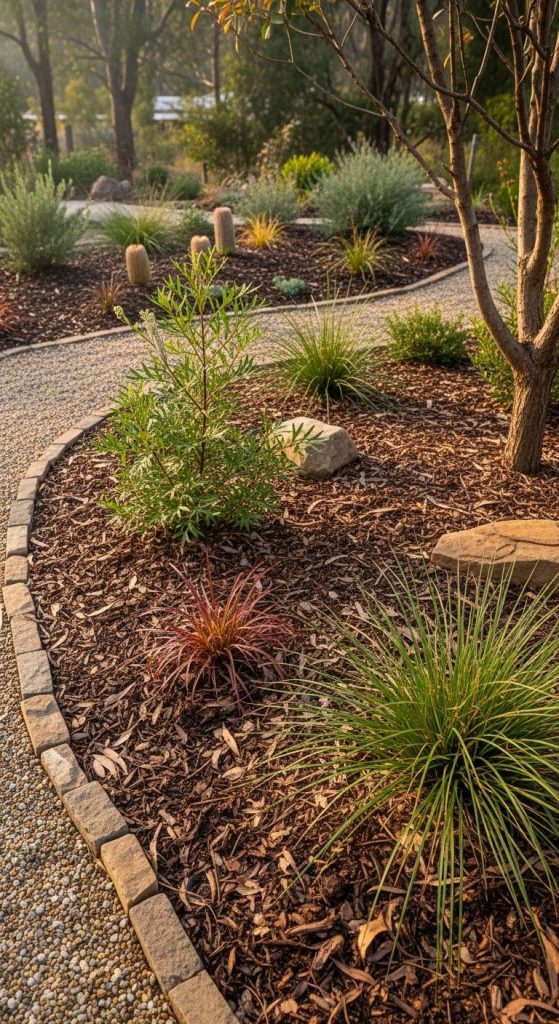
A good mulch layer like eucalypt bark or coarse leaf litter keeps soil moist, suppresses weeds, and visually ties together different plants.
Pros:
- Reduces watering and weeding
- Enhances soil health
- Adds rustic, earthy aesthetics
Cons:
- Needs replenishing periodically
- Can harbor slugs or insects if too thick
Mini takeaway: Mulch is a simple tool that makes your garden sustainable and visually cohesive.
8. Seasonal Flower Rotation

Even native plants have peak seasons. Pair early Wahlenbergia with later-flowering Xerochrysum or Brachyscome for continuous color.
Pros:
- Ensures year-round visual interest
- Encourages biodiversity
- Reduces gaps in flowering
Cons:
- Requires knowledge of flowering cycles
- Some species may struggle in harsh microclimates
Mini takeaway: Seasonal planting keeps your garden alive and engaging throughout the year.
9. Stone or Rock Accents
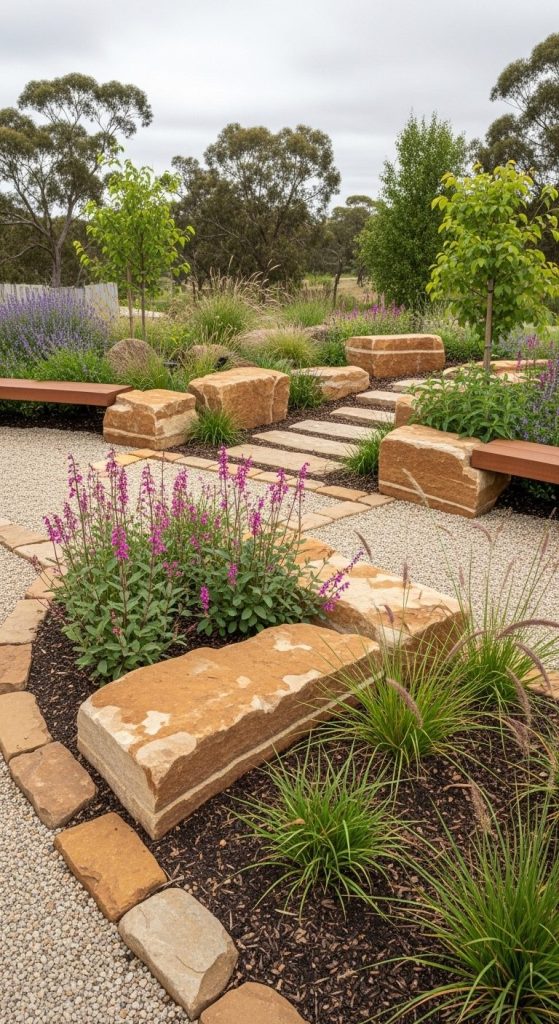
Natural stone or boulders placed strategically can define beds and create contrast with soft foliage. I like sandstone edging alongside Correas and native grasses.
Pros:
- Adds structure without rigidity
- Offers microhabitats for small fauna
- Provides visual balance
Cons:
- Large rocks require labor to position
- Can be expensive depending on material
Mini takeaway: Rocks subtly reinforce your cottage garden’s natural, grounded feel.
10. Native Grasses for Movement
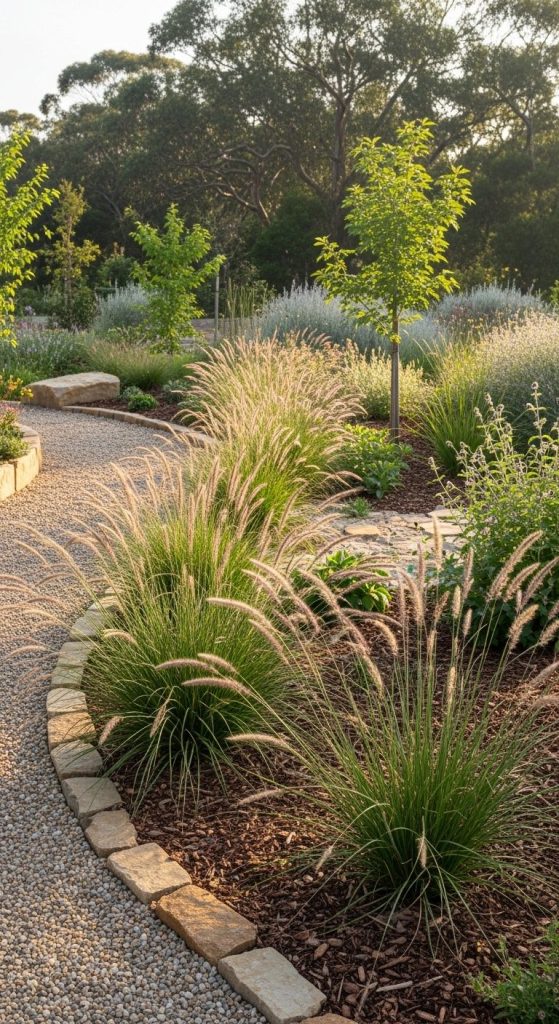
Grasses like Poa labillardieri and Themeda triandra bring movement, texture, and soft edges. I plant them along paths or bed margins to sway in the breeze.
Pros:
- Softens harder garden lines
- Enhances habitat value
- Low maintenance once established
Cons:
- Can spread if not monitored
- Some species may brown in dry periods
Mini takeaway: Grasses add an effortless, airy charm that keeps your garden lively.
11. Container Gardens for Flexibility
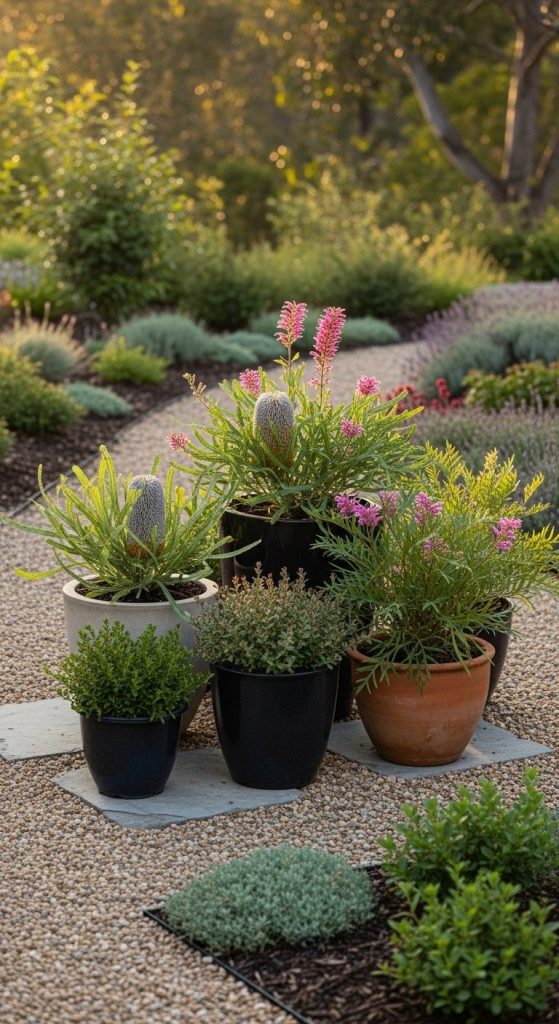
Potted Banksias, Correas, or Grevilleas can bring life to patios and narrow spaces. I often rotate pots seasonally to refresh colors.
Pros:
- Perfect for small spaces
- Allows experimentation with plant placement
- Adds height and focus
Cons:
- Pots require regular watering
- Restricted root growth if container too small
Mini takeaway: Containers extend your cottage garden into patios and courtyards easily.
12. Subtle Water Features
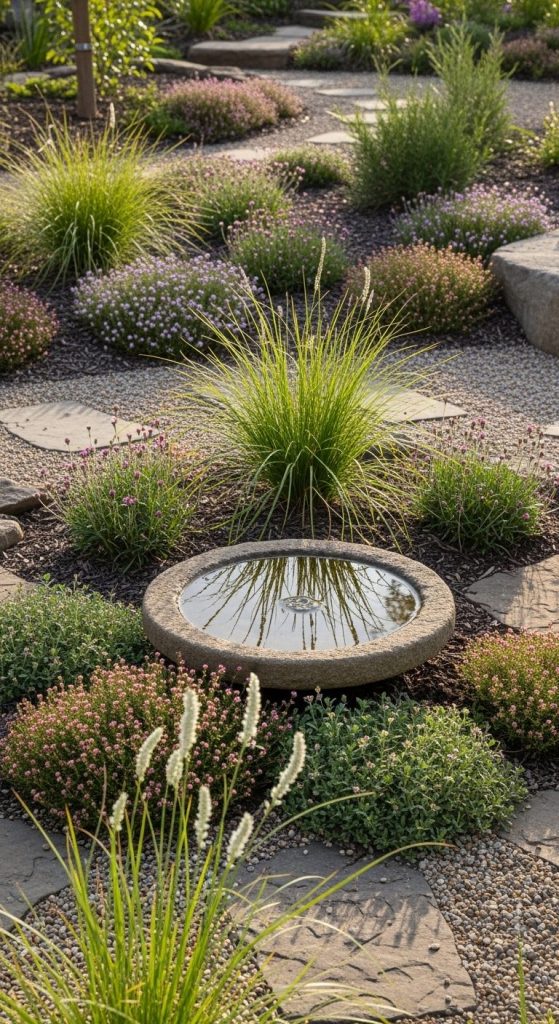
A small birdbath or shallow pond complements natives without requiring elaborate plumbing. I like natural stone basins surrounded by low groundcovers.
Pros:
- Attracts birds and insects
- Adds reflective visual interest
- Can be low maintenance
Cons:
- Needs occasional cleaning
- Can attract mosquitoes if stagnant
Mini takeaway: Even a tiny water feature creates a sense of life and tranquility.
13. Pathway Plant Edges

Bordering paths with low-growing native flowers or succulents like Dichondra or Brachyscome creates definition and charm.
Pros:
- Guides foot traffic
- Adds seasonal color at eye level
- Creates intimacy and rhythm
Cons:
- Low plants may get trampled
- Needs periodic trimming
Mini takeaway: Defined edges make walking through your garden a more immersive experience.
14. Aromatic Natives

Plants like Prostanthera or Boronia add fragrance. Placing them near seating areas or entryways amplifies sensory enjoyment.
Pros:
- Invites visitors with scent
- Enhances sensory layers
- Attracts pollinators
Cons:
- Some may be sensitive to frost or heat
- Requires pruning to maintain shape
Mini takeaway: Aroma makes your native cottage garden memorable and engaging.
15. Layered Lighting
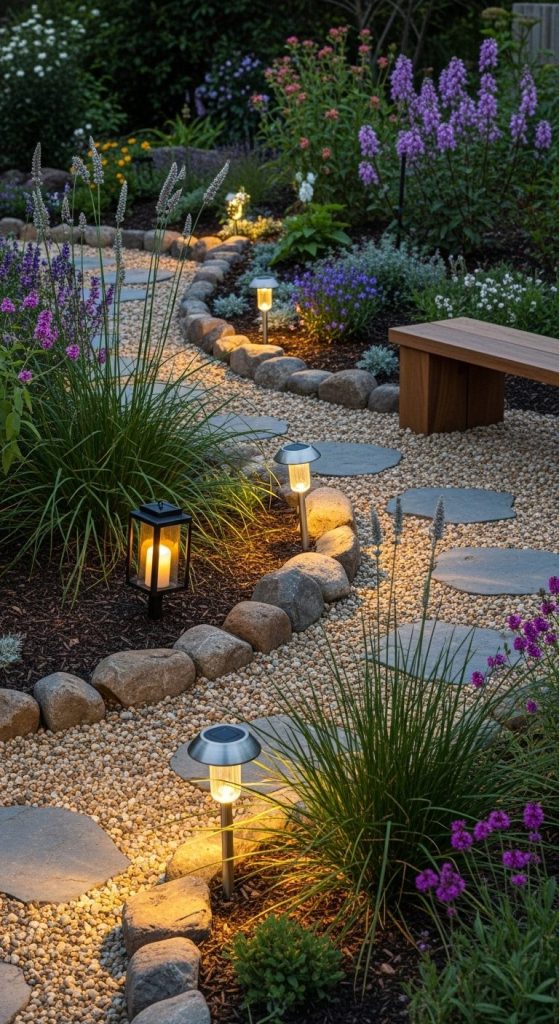
Soft solar garden lights or lanterns tucked among rocks, paths, or larger shrubs extend enjoyment into evenings without overpowering natural aesthetics.
Pros:
- Highlights plants and pathways
- Adds cozy evening ambiance
- Low energy, easy installation
Cons:
- Solar lights depend on sun exposure
- Some lights may fade or require replacement
Mini takeaway: Subtle lighting makes your garden usable and magical at night.
Conclusion
Creating an Australian native cottage garden is about blending practicality with beauty. By layering perennials, adding texture through stones, grasses, and mulch, and considering wildlife and seasonal rotation, you craft a space that feels alive, inviting, and effortlessly charming. My personal tip: start small, perhaps with a path and a few key plants, and let your garden evolve naturally. Over time, it becomes a sanctuary, buzzing with birds, color, and subtle fragrance—truly a space that connects you to both nature and home.
Try one idea first—maybe a cozy seating nook surrounded by Grevilleas or a gently curved gravel path—and watch your garden transform.

Ashley Ellison is a skilled writer and avid bowler. Her passion for storytelling and dedication to the sport have led her to participate in various national bowling leagues. With a unique combination of talents, Ashley approaches every challenge with creativity and a relentless drive to succeed.

